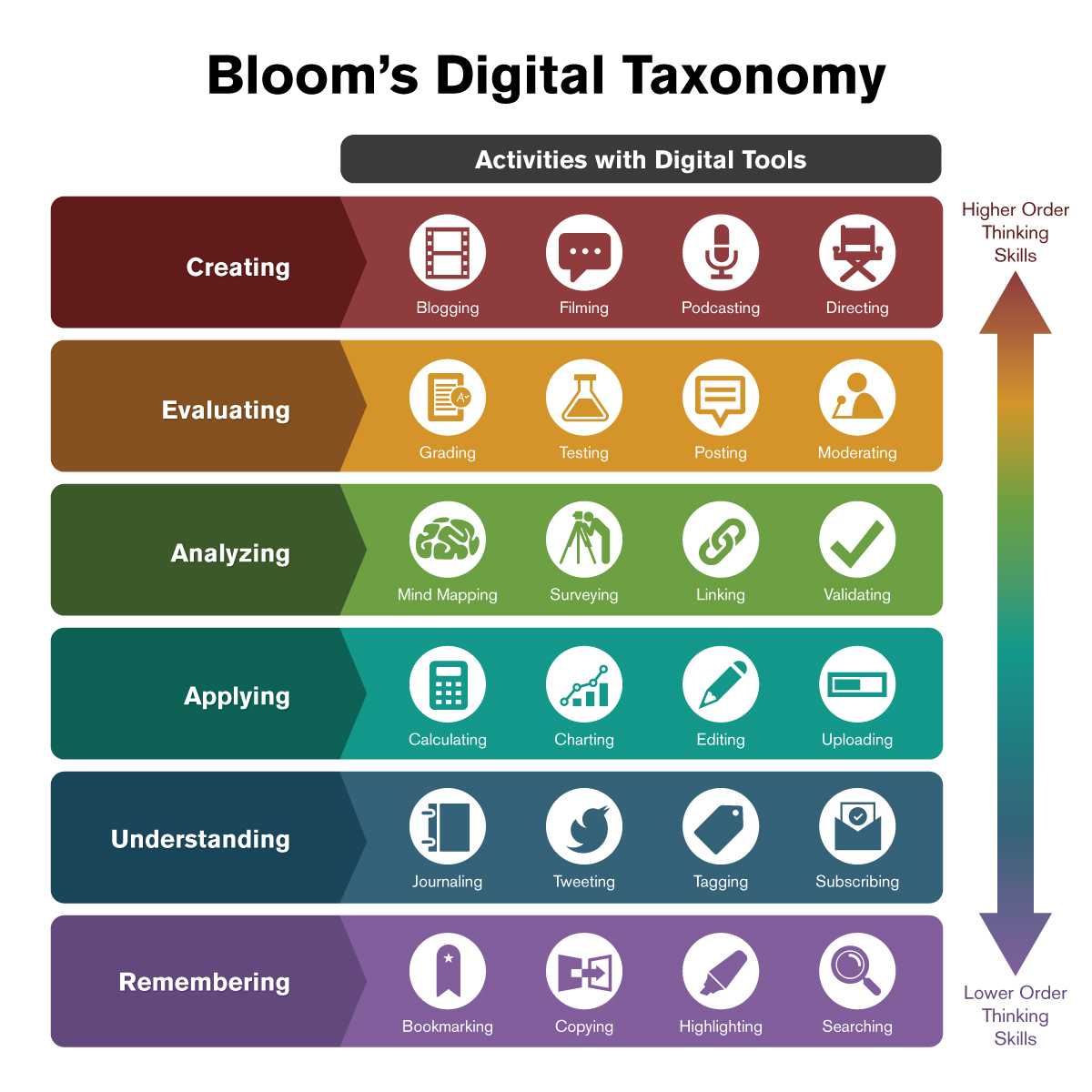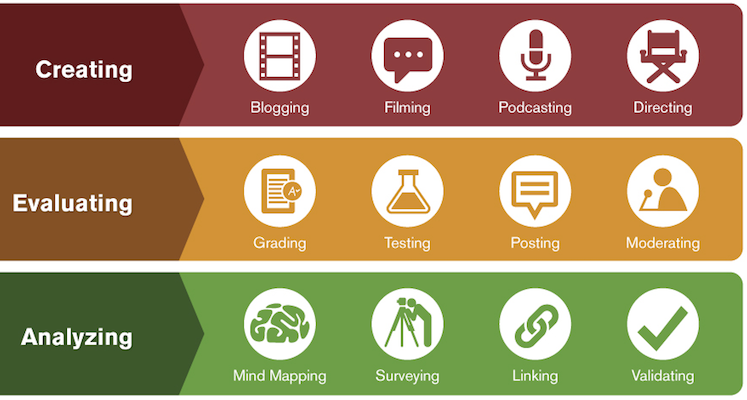Integrating Technology with Bloom’s Taxonomy
Creating authentic learning experiences for students is an essential element in online course delivery. Through recent discussion instructors have inquired “How do we provide meaningful learning experiences for students using tools that are intrinsically motivating?” 2 Questions as such imply the need to provide instructors with “. . . innovative ways of integrating technology that encourage higher-order thinking skills.” 2
Research indicates that “Today’s students, regardless of demographics, have shown an interest in digital opportunities to learn, and the range of Web 2.0 tools that make collaboration, innovation, and individual exploration possible is incredible.” 2 Practitioners within the field of education have thought of unique ways to connect digital tools with the framework of Bloom’s Revised Taxonomy, which has led to the emergence of a Digital Bloom’s Taxonomy.
Bloom’s Digital Taxonomy
The purpose of Bloom’s Digital Taxonomy is to inform instructors of how to use technology and digital tools to facilitate student learning experiences and outcomes. It aims, “To expand upon the skills associated with each level as technology becomes a more ingrained essential part of learning.” 1 The use of this adapted version and the examples of tools it provides focus “should not be on the tools themselves, but rather on how the tools can act as vehicles for transforming student thinking at different levels.” 1 Outlined below are the levels featured within Bloom’s Revised Taxonomy. Each level is accompanied by a description of its relevance and examples of digital tools that connect with this taxonomy framework.

Infographic Credit: Ron Carranza
Creating –To produce new or original work. Tools – Animating, blogging, filming, podcasting, publishing, simulating, wiki building, video blogging, programming, directing
Evaluating – To justify a stand or decision; to make judgements based on criteria and standards through checking and critiquing. Tools – Grading, networking, rating, testing, reflecting, reviewing, blog commenting, posting, moderating
Analyzing – To draw connections among ideas, concepts, or determining how each part interrelate to an overall structure or purpose. Tools – Mashing, mind mapping, surveying, linking, validating
Applying – To use information in new situations such as models, diagrams, or presentations. Tools – Calculating, Charting, editing, hacking, presenting, uploading, operating, sharing with a group
Understanding – To explain ideas, concepts, or construct meaning from written material or graphics. Tools – Advanced searching, annotating, blog journaling, tweeting, tagging, commenting, subscribing
Remembering – To recall facts, basic concepts, or retrieval of material. Tools – Bookmarking, copying, googling, bullet-pointing, highlighting, group networking, searching
Summary
Connecting characteristics of Bloom’s Revised Taxonomy is necessary for creating online learning activities that are in accordance with our students’ needs. “Bloom’s Digital Taxonomy helps us navigate through the myriad digital tools and make choices based on the kinds of learning experiences we want students to engage in.” 2 Selecting the most appropriate digital activity will depend on the activity’s level of difficulty tied to the cognitive levels stated within Bloom’s Revised Taxonomy. As K. A. Meyer writes, “Knowledge is situated, being in part a product of the activity, context, and culture in which it is developed and used. In this way, we can begin to ascertain differences that will help instructors apply the right tool to the right learning goals.” 3
References
1 Bloom’s Digital Taxonomy. (2015, January 15). Retrieved May 03, 2016, from https://www.commonsensemedia.org/videos/blooms-digital-taxonomy
2 Lightle, K. (2011). More than just the technology. Science Scope, 34(9), 6-9.
3 Meyer, K. A. (2010). A comparison of Web 2.0 tools in a doctoral course. The Internet and Higher Education, 13(4), 226-232. doi:10.1016/j.iheduc.2010.02.002
Additional Resources
Center for Teaching – Bloom’s Revised Taxonomy https://cft.vanderbilt.edu/guides-sub-pages/blooms-taxonomy/
Fractus Learning – Bloom’s Digital Taxonomy http://www.fractuslearning.com/2014/08/18/blooms-taxonomy-digital-print-table/
Global Digital Citizen’s Foundation – Bloom’s Digital Taxonomy Verbs https://globaldigitalcitizen.org/blooms-digital-taxonomy-verbs



